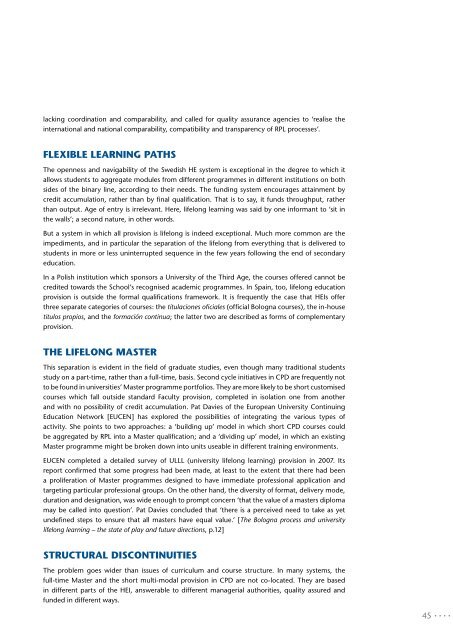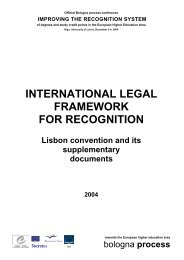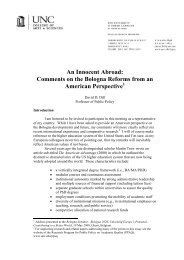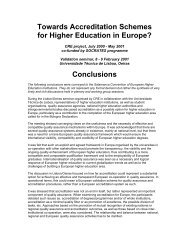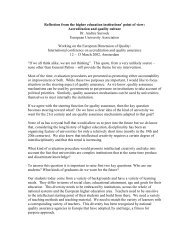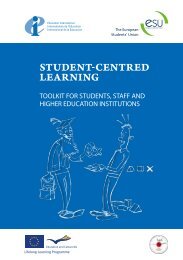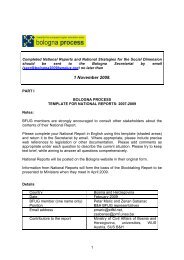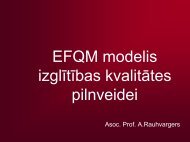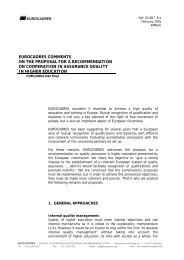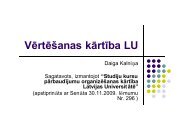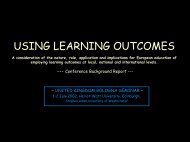EUA Survey Of Master Degrees In Europe - European University ...
EUA Survey Of Master Degrees In Europe - European University ...
EUA Survey Of Master Degrees In Europe - European University ...
You also want an ePaper? Increase the reach of your titles
YUMPU automatically turns print PDFs into web optimized ePapers that Google loves.
lacking coordination and comparability, and called for quality assurance agencies to ‘realise theinternational and national comparability, compatibility and transparency of RPL processes’.Flexible learning pathsThe openness and navigability of the Swedish HE system is exceptional in the degree to which itallows students to aggregate modules from different programmes in different institutions on bothsides of the binary line, according to their needs. The funding system encourages attainment bycredit accumulation, rather than by final qualification. That is to say, it funds throughput, ratherthan output. Age of entry is irrelevant. Here, lifelong learning was said by one informant to ‘sit inthe walls’; a second nature, in other words.But a system in which all provision is lifelong is indeed exceptional. Much more common are theimpediments, and in particular the separation of the lifelong from everything that is delivered tostudents in more or less uninterrupted sequence in the few years following the end of secondaryeducation.<strong>In</strong> a Polish institution which sponsors a <strong>University</strong> of the Third Age, the courses offered cannot becredited towards the School’s recognised academic programmes. <strong>In</strong> Spain, too, lifelong educationprovision is outside the formal qualifications framework. It is frequently the case that HEIs offerthree separate categories of courses: the titulaciones oficiales (official Bologna courses), the in-housetitulos propios, and the formación continua; the latter two are described as forms of complementaryprovision.The lifelong <strong>Master</strong>This separation is evident in the field of graduate studies, even though many traditional studentsstudy on a part-time, rather than a full-time, basis. Second cycle initiatives in CPD are frequently notto be found in universities’ <strong>Master</strong> programme portfolios. They are more likely to be short customisedcourses which fall outside standard Faculty provision, completed in isolation one from anotherand with no possibility of credit accumulation. Pat Davies of the <strong>Europe</strong>an <strong>University</strong> ContinuingEducation Network [EUCEN] has explored the possibilities of integrating the various types ofactivity. She points to two approaches: a ‘building up’ model in which short CPD courses couldbe aggregated by RPL into a <strong>Master</strong> qualification; and a ‘dividing up’ model, in which an existing<strong>Master</strong> programme might be broken down into units useable in different training environments.EUCEN completed a detailed survey of ULLL (university lifelong learning) provision in 2007. Itsreport confirmed that some progress had been made, at least to the extent that there had beena proliferation of <strong>Master</strong> programmes designed to have immediate professional application andtargeting particular professional groups. On the other hand, the diversity of format, delivery mode,duration and designation, was wide enough to prompt concern ‘that the value of a masters diplomamay be called into question’. Pat Davies concluded that ‘there is a perceived need to take as yetundefined steps to ensure that all masters have equal value.’ [The Bologna process and universitylifelong learning – the state of play and future directions, p.12]Structural discontinuitiesThe problem goes wider than issues of curriculum and course structure. <strong>In</strong> many systems, thefull-time <strong>Master</strong> and the short multi-modal provision in CPD are not co-located. They are basedin different parts of the HEI, answerable to different managerial authorities, quality assured andfunded in different ways.45


